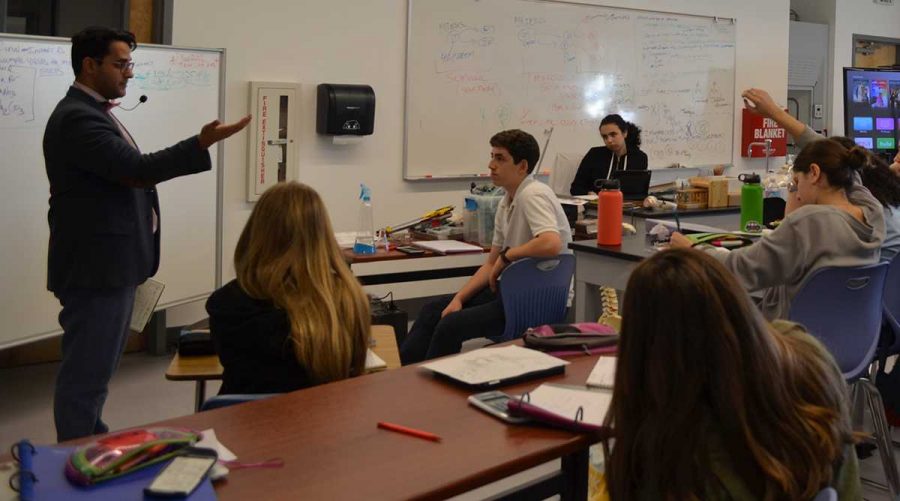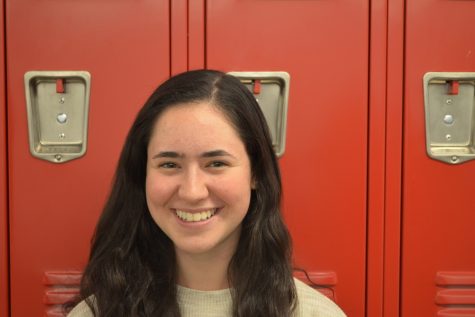Faster-paced classes added to science curriculum for spring semester
Meeting mostly at lunch and online, new sections require more student initiative
SAS Biology teacher and year-old Head of Science Department taught an advanced Chemistry class, which was established mid-year for sophomores.
February 21, 2017
The start of second semester saw the introduction of two new advanced science classes, in response to some students’ concerns that the Chemistry and Physics courses offered this year were not challenging enough.
Instead of waiting until next year to remedy the problem, the administration decided to act mid-year.
“Looking at the first semester in review, there was a need to look at and create a more robust experience for some of our students,” said General Studies Principal Mr. Daniel Weslow.
Tenth-graders in the new chemistry class were previously students of Mr. Tushar Dwivedi, who said he was pleased with the solution because the range of needs in his two chemistry classes was too large.
“In order for me to kind of make sure that there weren’t too many students being left behind, I had to go at a slower pace at times and review things and go over things quite a bit,” Mr. Dwivedi said, “and that would end up being frustrating to the students who already understood it and were faster.”
Sophomore Eytan Kent said he switched into the new chemistry class to keep his options open for more study in the future.
“I just want to improve my skills overall in science,” said Eytan. “Even though I might not necessarily want to become something in science, I still want to keep my options open.”
Adding new courses to the schedule took some creative staffing and logistics.
The new Chemistry class – currently with around 23 students – has been meeting during Monday lunch, Tuesday SWAP and Thursday breakfast. Those who switched in now have three free periods during what used to be Chemistry.
The new Physics class only meets twice a week – last period on Thursday and once a week online. Yael Marcus, who switched from Mr. Dwivedi’s 12th grade physics class, and Talya Ohana, who switched from Mrs. Gidanian’s SAS Physics.
Both classes officially are being co-taught by Science Department Chair and teacher Mr. Ayden Jacob and his wife, Ms. Sharon Cohen, an embryologist at Cedars-Sinai Medical Center. Ms. Cohen, who has not yet taught a class in person, has been out of town and not available to be interviewed during the first weeks of the semester.
That means Mr. Jacob has been teaching both classes for now, in addition to three ninth-grade biology classes and the SAS Advanced Biology course. He said Ms. Cohen would start co-teaching the Chemistry class with him soon, by posting videos to Schoology in which she explains the homework.
Mr. Weslow said the co-teaching model was arranged so students could have someone who was always on campus — Mr. Jacob — in addition to a teacher off-site who would explain the material in further detail.
Ms. Cohen was chosen, he said, partly because students liked her teaching when she substituted for Mr. Dwivedi while he was on paternity leave in November and December, and partly because she was available to jump in mid-year.
Both classes also use GoToMeeting, an app that lets a teacher to share his or her computer screen or teach via video call. It is typically live, although the teacher also has the option to save a recording of the entire video session and post it to Schoology.
The same app is also used in the AP Computer Science course, whose students meet with their teacher, Dr. Josh Sharfman, only once a week in person.
According to Mr. Jacob, the Chemistry class uses a “guided learning” style, with students expected to read the textbook on their own and come to class prepared to solve problems.
“It’s a huge responsibility” for the students, Mr. Jacob said. “It’s tough. But the class is based around analyzing chemical problems, as opposed to memorizing facts.”
Mr. Jacob introduces the problem sets, and Ms. Jacob explains the concepts in further detail and reviews answers in class, if she can be at school, or during Go-To meetings.
“Because the kids who are coming in to the class are coming in on the premise of enrichment learning – they are doing it for the interest of learning itself — I think every kid in there is ready to move quickly,” Mr. Jacob said.
Eytan Kent is pleased with the new arrangement, but worried about the large class size.
“It might slow us down a little bit just because the whole entire class needs to get it, not just 10 or 12 people” out of the roughly 23, Eytan said.
Also, flexibility that would have been made possible by Go-To meetings — possibly holding class meetings after school or on weekends, he said — is prevented by the class size.
“Because there are so many people, it’s going to be hard to change the classes for timing,” said Eytan.
The flip side of the large advanced class, however, is a smaller “original” class taught by Mr. Dwivedi — just nine students as of this week, though the numbers are still changing as some students are changing their minds about where they want to be.
“Now that it’s such a small environment, it’s easier for him to get all of our attention and it’s easier for us to get his attention,” said sophomore Abbi Sentchuk, who has stayed in her original science class, “so I feel like it’s just a better environment as a whole.”
Mr. Dwivedi agreed.
“It’s working out quite well because the students that have remained are able to get exactly what they needed, which is more focused attention and more help,” Mr. Dwivedi said.
Sophomore Ayala Chocron said she initially switched into the new class because she thought it would be more organized and “learning-focused.” But after a couple of classes, she decided that the workload was too heavy and the class too big.
“You can still get into SAS classes from being in [Mr. Dwivedi’s] class,” said Ayala. “So I just felt like I don’t learn well in a learning environment where there are a lot of people, like I can’t get one-on-one attention, so I just felt that the old class would be easier at least.”
Like the new Chemistry class, the new Physics class involves a lot of learning outside of class. But the Physics class has just two students.
According to senior Talya Ohana, who shares the class with fellow senior Yael Marcus, they are expected to read the chapter at home and complete weekly homework assignments, which are due last period Thursday, when they meet with Ms. Jacob in person. Ms. Jacob has been there in person for this class at least once.
“It’s a lot of, like, ‘Get your stuff done outside of class, so when we’re in class we’re not wasting time,’” said Talya, who was in Mrs. Gidanian’s SAS Physics course first semester. She said she joined the new class because she wanted a class that was less challenging, but also not too relaxed.
“Being a second-semester senior, I didn’t want to struggle in Mrs. Gidanian’s class any more,” Talya said. “I wanted a happy medium where I would still learn physics but not at the fast pace Mrs. Gidanian was teaching at.”
Mr. Jacob said some seniors who complained about their Physics class first semester did not end up switching because they are already “one foot out the door.”
“I think this has to do with human nature,” Mr. Jacob said. “It’s difficult to get people who are already comfortable with a certain style to want to switch. But Shalhevet wanted to offer them that anyway.”














